San Juan
Preparazione del gioco
You can enter the game with /join. The game begins with /start (2-4 players). Alternatively, you can use the game management!
Il gioco

San Juan runs over several rounds. In each round, each player chooses one of five different roles and thus initiates a specific action for all players. For example, with the help of the overseer, goods are produced, which are then sold to the trading house by dealers. With the money earned, you can use the builder to build buildings in San Juan, etc.
(The special thing about SJ is: Each playing card has several functions: Buildings (open on display), money (in hand) or goods (on the production building))
The course of the game and the roles
The game runs over several rounds (usually 11-14). Each round, each player chooses a different role. He performs the action of the role plus his privilege. The other players then carry out the action in turn. Once each player has chosen a role and all players have carried out the corresponding action, the round ends.
At the end of the round, everyone is only allowed to have a maximum of 7 cards in their hand. Excess cards must be handed in. Unless you have already built the tower building, then you can hold 12 cards.
With 2 players, the starting player of the round always chooses two roles. (a-b-a)
The other thing to remember about the library is that it can only be used once per round (you can deactivate it the first time you choose a role by clicking away the blue check mark) .
Builder:
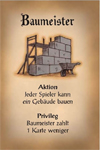
The player who chooses this role can then build any building by he clicks on the corresponding hand card at the bottom left. He now pays the construction costs indicated on the card by clicking on additional cards in his hand (= money) and handing them over. His privilege allows him to save a card. He then clicks on the arrow to confirm.
A player may build any number of production buildings multiple times during the course of the game, but each purple building can only be built once.
< div class="clear">Overseer:
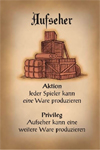
The player who chooses this role begins producing goods. He clicks on two of his production buildings and confirms with the arrow. Each production building can store a maximum of one good. The other players follow accordingly and produce a good.
Dealer:
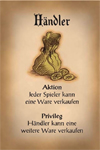 < p> This action first reveals a trading house tile. The player then clicks on two of his goods that he would like to sell (the card shows the current prices). He confirms with an arrow. The other players follow and sell a good.
< p> This action first reveals a trading house tile. The player then clicks on two of his goods that he would like to sell (the card shows the current prices). He confirms with an arrow. The other players follow and sell a good. There are 5 trading house cards that are not shuffled again in the game.
Councilman:
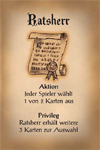
The player who chooses this role gets 5 cards to look at. He may choose one and put it into his hand. The remaining players get 2 cards to look at.
Gold prospector:
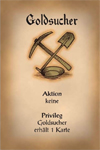
The player who chooses this role receives a card from the stack.
Notes on handling
Buildings have a construction price at the top and a victory point value at the bottom. Their use is voluntary.
The number of cards in hand of all players can be seen as a rollover in the middle of the game board.
Fine del gioco
The game ends immediately after the builder phase, in which the first player has built his 12th building. The player with the most victory points wins. In the event of a tie, the sum of the remaining hand cards and goods decides.
The complete instructions
for this more complex game can be found {6 }here.

